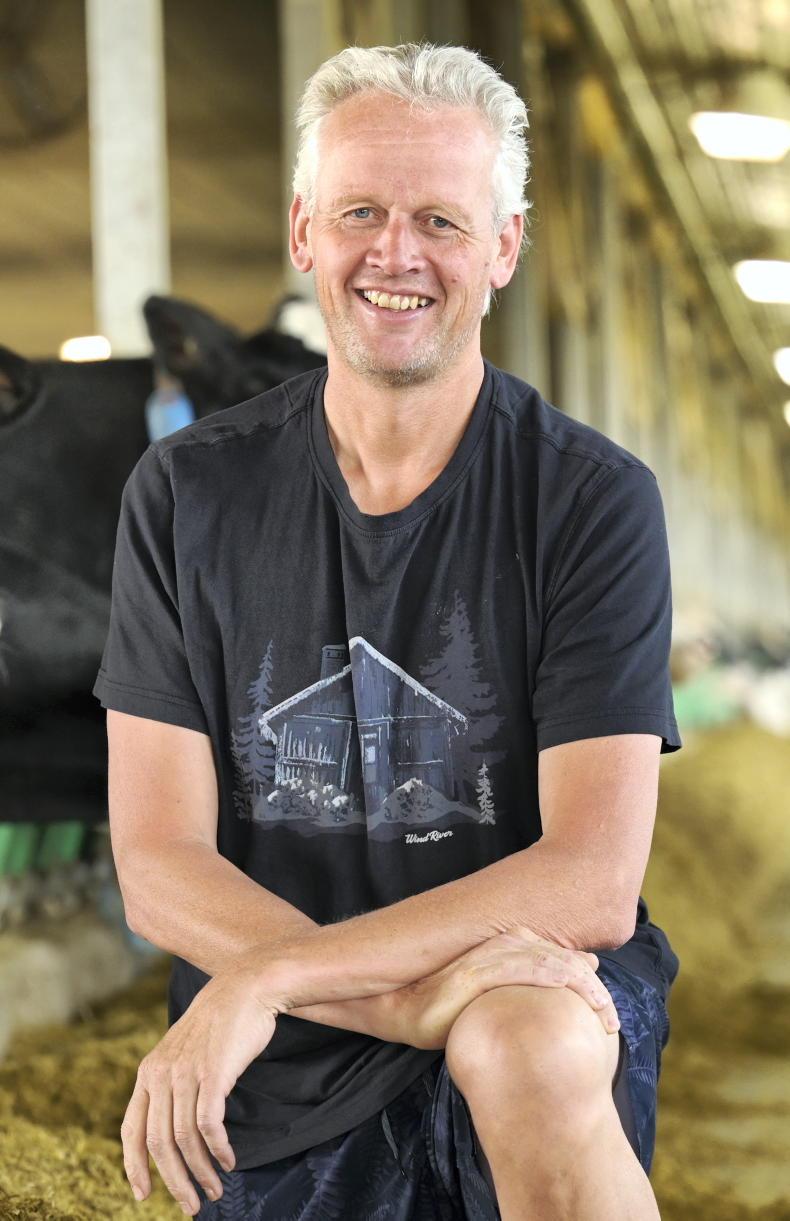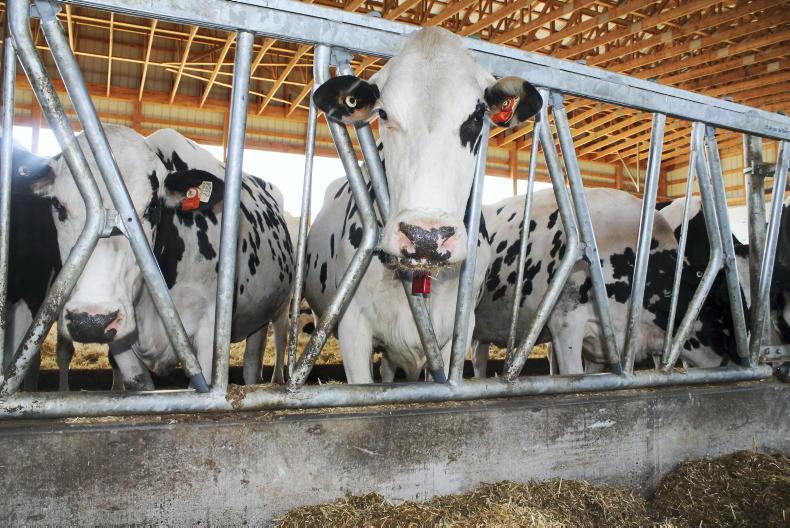A new wave of European farmers are buying dairy farms in Canada on the back of tightening EU environmental regulations, a Canadian dairy industry leader has said.
While the move is not happening at the same rate as during the 1990s, demand for farms by people coming from Europe – especially from the Netherlands – has been particularly noted in the province of Alberta in recent times.
It comes as the Canadian dairy industry expects to come under increased pressure “to feed the world” as policies and laws to reduce agricultural emissions are projected to reduce production capacity in the EU and New Zealand in the decades ahead.
Speaking to the Irish Farmers Journal at the International Federation of Agricultural Journalists Congress 2023 in Canada, Gert Schrijver – originally from the Netherlands but milking in Stettler, Alberta, for almost 30 years – says there are advantages and drawbacks to such scenarios.

Gert Schrijver on his home farm. / Christian Muhlhausen, Landpixel
“A new wave is happening already, not at as big of a scale as in the 1990s, but it is happening in smaller numbers.
“In the 1990s farmers came because they still had the quota system in Europe, they don’t have that anymore so to make it financially viable it will be more difficult for them because the cost of quota is so high in Canada... around $50-60,000/cow (€33,900-€40,700/cow) in Alberta,” Schrijver said.
Demand for farms
“It’s especially from the Netherlands right now, they are coming to Alberta. I don’t know about Eastern Canada but there is demand for farms from people coming from Europe for sure.
“It will only continue to grow if they are able to sell their farms in Europe for enough money.
“If a value is put on phosphate and nitrates rights it will make it easier for them to sell and move to Canada,” he maintained.
“It’s mostly young farmers that are making the move, the next generation. In Holland there is also no succession planning so that’s why they are leaving too.”
Average Alberta farmland prices rose 10% last year, according to Farm Credit Canada statistics released in March 2023.
The average price of farmland and buildings was CAN$3,380/ac or €2,299/ac across the entire province, with large variations between pasture and cultivated land, and irrigated land fetching up to CAN$14,916/ac or €10,137/ac.

The Canadian Dairy Commission, a government corporation, manages the milk price with the provinces so all revenues get shared and all farmers receive the same milk price annually. This year’s milk price is set at 94c/l. / Claire McCormack
Schrijver, who is a board member and director for Alberta Milk and Dairy Farmers of Canada, predicts that once the dairy sector reaches carbon neutrality by 2050, having pioneered work on genetic selection of low methane-emitting cows since 2017, the country’s vast agricultural land base will be targeted to ramp up output.
While this would lead to further development of Canada’s already growing dairy industry, the Dutchman fears it may threaten the sector’s envied 55-year-old milk supply management system that allows producers “to be price-setters rather than price takers”.
He explains how Canadian farmers are in a situation which Irish farmers, this week bearing the brunt of severe milk price cuts, might currently envy.
Supply management
“In Canada we still operate in a milk supply management system, that’s something that they had in the past in Europe, 10 or 20 years ago.
“The reason our supply management system was established in 1968 was to supply enough dairy for our own population.
“Before that it was really seasonal and the focus was to have a consistent supply of dairy products and filling our markets and to make sure there is a fair income for the farmer.
“Now, we produce about 27m litres per day, and this is all for domestic production, we don’t export a whole lot.
“We do a cost-of-production study on a couple of hundred farms every year and the milk price is based on that, so we are not as much price takers, we are more price setters and that is something different than we see in the rest of the world.”
A new wave of European farmers are buying dairy farms in Canada on the back of tightening EU environmental regulations, a Canadian dairy industry leader has said.
While the move is not happening at the same rate as during the 1990s, demand for farms by people coming from Europe – especially from the Netherlands – has been particularly noted in the province of Alberta in recent times.
It comes as the Canadian dairy industry expects to come under increased pressure “to feed the world” as policies and laws to reduce agricultural emissions are projected to reduce production capacity in the EU and New Zealand in the decades ahead.
Speaking to the Irish Farmers Journal at the International Federation of Agricultural Journalists Congress 2023 in Canada, Gert Schrijver – originally from the Netherlands but milking in Stettler, Alberta, for almost 30 years – says there are advantages and drawbacks to such scenarios.

Gert Schrijver on his home farm. / Christian Muhlhausen, Landpixel
“A new wave is happening already, not at as big of a scale as in the 1990s, but it is happening in smaller numbers.
“In the 1990s farmers came because they still had the quota system in Europe, they don’t have that anymore so to make it financially viable it will be more difficult for them because the cost of quota is so high in Canada... around $50-60,000/cow (€33,900-€40,700/cow) in Alberta,” Schrijver said.
Demand for farms
“It’s especially from the Netherlands right now, they are coming to Alberta. I don’t know about Eastern Canada but there is demand for farms from people coming from Europe for sure.
“It will only continue to grow if they are able to sell their farms in Europe for enough money.
“If a value is put on phosphate and nitrates rights it will make it easier for them to sell and move to Canada,” he maintained.
“It’s mostly young farmers that are making the move, the next generation. In Holland there is also no succession planning so that’s why they are leaving too.”
Average Alberta farmland prices rose 10% last year, according to Farm Credit Canada statistics released in March 2023.
The average price of farmland and buildings was CAN$3,380/ac or €2,299/ac across the entire province, with large variations between pasture and cultivated land, and irrigated land fetching up to CAN$14,916/ac or €10,137/ac.

The Canadian Dairy Commission, a government corporation, manages the milk price with the provinces so all revenues get shared and all farmers receive the same milk price annually. This year’s milk price is set at 94c/l. / Claire McCormack
Schrijver, who is a board member and director for Alberta Milk and Dairy Farmers of Canada, predicts that once the dairy sector reaches carbon neutrality by 2050, having pioneered work on genetic selection of low methane-emitting cows since 2017, the country’s vast agricultural land base will be targeted to ramp up output.
While this would lead to further development of Canada’s already growing dairy industry, the Dutchman fears it may threaten the sector’s envied 55-year-old milk supply management system that allows producers “to be price-setters rather than price takers”.
He explains how Canadian farmers are in a situation which Irish farmers, this week bearing the brunt of severe milk price cuts, might currently envy.
Supply management
“In Canada we still operate in a milk supply management system, that’s something that they had in the past in Europe, 10 or 20 years ago.
“The reason our supply management system was established in 1968 was to supply enough dairy for our own population.
“Before that it was really seasonal and the focus was to have a consistent supply of dairy products and filling our markets and to make sure there is a fair income for the farmer.
“Now, we produce about 27m litres per day, and this is all for domestic production, we don’t export a whole lot.
“We do a cost-of-production study on a couple of hundred farms every year and the milk price is based on that, so we are not as much price takers, we are more price setters and that is something different than we see in the rest of the world.”








 This is a subscriber-only article
This is a subscriber-only article











SHARING OPTIONS: